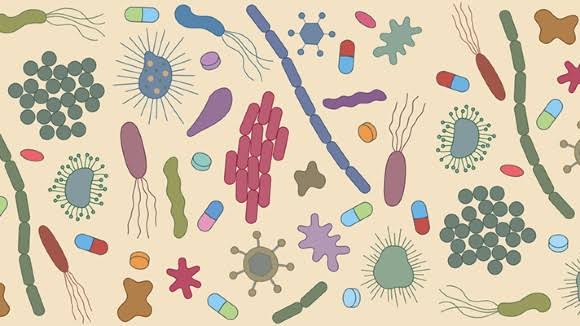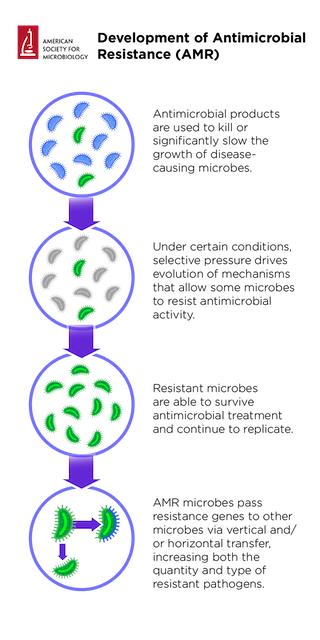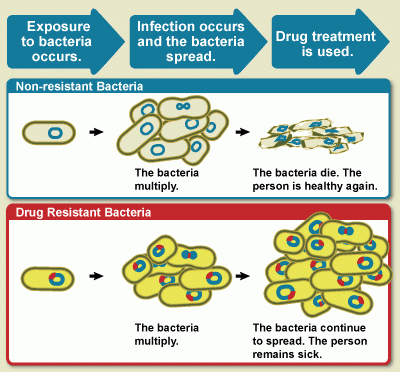ANTIBIOTICS; THE DOUBLE EDGED SWORDS.
ANTIMICROBIALS; THE DOUBLE EDGED SWORDS.
"For precept must be upon precept, precept upon precept; line upon line, line upon line; here a little, and there a little.."
I want to believe you will agree with me that we can only understand what ANTIMICROBIALS are if we know what MICROBES are..
Dear Readership, we have a very important topic here and trust me it's of Global Importance and as such I would implore you to read gently and I promise that I will be as gentle as possible.
Now, let's set the sail right so we can sail effortlessly.
MICROBES are also known as Microorganisms and they are tiny living organisms that are too small to be seen with the naked eye and for context sake, they are causative agents of diseases. Examples are Viruses, Bacteria, Fungi, Protozoa and Algae. They are found everywhere.
"What is crooked cannot be straightened; and what is lacking cannot be counted".
Now, ANTIMICROBIALS are agents that inhibit the growth of or kill microorganisms, such as bacteria, viruses, fungi, and protozoa. They are used to prevent and treat infections, and can be classified into several types:
A. Antibiotics: specifically target bacteria, e.g., penicillin, amoxicillin, and ciprofloxacin.
B. Antivirals: target viruses, e.g., oseltamivir and zanamivir.
C. Antifungals: target fungi, e.g., fluconazole (Diflucan) and amphotericin
D. Antiparasitics: target protozoa and helminths (worms), e.g. albendazole.
E. Disinfectants: reduce microbial load on surfaces, e.g., bleach and hydrogen peroxide.
F. Antiseptics: reduce microbial load on living tissues, e.g., hand sanitizers and wound cleansers.
It is also worthy to note that Antimicrobials can be used in various ways, including:
- Treating infections
- Preventing infections (prophylaxis)
- Reducing microbial load (decontamination)
- Controlling microbial growth (biostasis).
Dear Readership, they are that very useful, howbeit, if proper caution isn't taken, there could be a very big problem and in recent times this big problem has been ascertained to have crept in silently.
ANTIMICROBIAL RESISTANCE (AMR) refers to the ability of microorganisms (bacteria, viruses, fungi, and parasites) to resist the effects of antimicrobial agents, such as antibiotics, antivirals, and antifungals. This means that the medications used to treat infections become less effective or even useless against as these microbes that are causative agents of these infections have become "superbugs".
Dear Readership, I know the next question brewing in your mind is "What then are the causes of AMR?"
Of course, there are so many causes but I will discuss some of them, and extensively.
A. OVER PRESCRIPTION AND MISUSE OF ANTIMICROBIALS - Overprescription and misuse of antimicrobials are significant contributors to the development of Antimicrobial Resistance (AMR). Here's how:
1. Overuse: Excessive prescribing of antimicrobials for viral infections, such as common colds and flu, which don't respond to antibiotics.
2. Misdiagnosis: Incorrectly diagnosing bacterial infections and prescribing antimicrobials when they're not needed.
3. Overprescribing: Prescribing antimicrobials for longer durations or in higher doses than necessary.
4. Lack of stewardship: Failure to monitor and adjust antimicrobial use based on patient response or changing resistance patterns.
5. Self-medication: Using antimicrobials without a prescription or medical supervision.
6. Poor infection control: Inadequate hygiene, sterilization, and infection control practices in healthcare settings.
B. AGRICULTURAL USE OF ANTIMICROBIALS - The use of Antimicrobials (Especially Antibiotics) in Livestock Farming has contributed to the emergence of AMR and SUPER BUGS. Farmers tend to use these drugs to prevent the occurrence of diseases and ultimately to reduce costs of production and to maximize profits, however, they're doing this at the detriment of the lives of the consumers. Incessant use of Antibiotics in Livestock Farming leaves residues the products that get sold to the consumers.. and so indirectly, it's a form of ANTIMICROBIAL MISUSE.
Before we delve into the consequences of AMR, I want Us to look into how these super bugs develop.. Dear Readership, you have come too far to get tired. You have come to far to return without getting to your destination. In few minutes, you'll be done reading this piece. It's a bit complex but I will simplify it so that this can be worth your while.
Dear Readership, when you use Antimicrobials in a way that does not favour the total elimination of these microbes (through ways listed above), the microbes get exposed to these antimicrobials and this exposure creates a selection pressure, favoring microbes that have genetic mutations or other mechanisms that confer resistance. As a result, microbes develop genetic mutations that alter the target of the antimicrobial, reducing its effectiveness.
Furthermore, resistant microbes share their genetic material with other microbes through horizontal gene transfer, spreading resistance. This process allows microbes to rapidly adapt and evolve, making them more resistant to antimicrobials. Natural selection also plays a crucial role, as resistant microbes survive and multiply, passing their resistance traits to their offspring.
In addition, microbes develop adaptive mechanisms, such as efflux pumps, biofilms, or enzyme production, to counteract the antimicrobial. These mechanisms enable microbes to survive and thrive in the presence of antimicrobials. Compensatory evolution also occurs, where microbes undergo additional changes to counteract the antimicrobial.
Finally, resistance becomes fixed in the microbial population, making the antimicrobial ineffective. This complex process involves multiple factors and mechanisms, driving the emergence and spread of antimicrobial-resistant microbes.
NOW, WHAT ARE THE CONSEQUENCES OF AMR?
The impact of Antimicrobial Resistance (AMR) on human health is significant and far-reaching. Some of the key consequences include:
1. Increased morbidity and mortality: AMR leads to reduced effectiveness of treatments, resulting in prolonged illnesses, increased mortality rates, and reduced quality of life.
2. Prolonged hospitalizations: AMR infections require longer hospital stays, increasing healthcare costs and the risk of hospital-acquired infections.
3. Increased healthcare costs: AMR leads to higher healthcare expenditures due to prolonged treatments, additional testing, and increased hospitalizations.
4. Reduced effectiveness of modern medicine: AMR compromises the effectiveness of modern medical procedures, such as organ transplants and cancer chemotherapy.
5. Increased risk of pandemics: AMR increases the risk of pandemics, as resistant infections can spread rapidly worldwide.
6. Disproportionate impact on vulnerable populations: AMR disproportionately affects vulnerable populations, including the elderly, young children, and those with compromised immune systems.
And then Finally.. FEW STRATEGIES TO COMBAT AMR include;
1. IMPROVED ANTIMICROBIAL STEWARDSHIP -Simply put, use drugs the way you're supposed to use them. Only use drugs when the Doctor ask you to and how he has prescribed them. Do not indulge in self medication. If you imbibe this habit, you're playing a very big role in curbing the effects of AMR.
2. PUBLIC AWARENESS - And this is exactly what I have done. Be a part of this struggle. Tell people that are very close to you about this. Let your Daddy, Mummy, Grandparents, etc know that drug misuse and abuse is bad. They don't have to take Flagyl Everytime they have stomach upset. They don't have to take paracetamol everytime they have headaches. Do the little you can in this struggle.
And finally, as the MBN would always say.. "till we get to the promised land, I shall be waiting for when you'll pass me a glass of water and thank God for the gift of grace for this race."
For upon precept upon precept, line upon line, here a little and there a little.. we have built this castle.
Cheers to Infinity and Beyond!
"For precept must be upon precept, precept upon precept; line upon line, line upon line; here a little, and there a little.."
I want to believe you will agree with me that we can only understand what ANTIMICROBIALS are if we know what MICROBES are..
Dear Readership, we have a very important topic here and trust me it's of Global Importance and as such I would implore you to read gently and I promise that I will be as gentle as possible.
Now, let's set the sail right so we can sail effortlessly.
MICROBES are also known as Microorganisms and they are tiny living organisms that are too small to be seen with the naked eye and for context sake, they are causative agents of diseases. Examples are Viruses, Bacteria, Fungi, Protozoa and Algae. They are found everywhere.
"What is crooked cannot be straightened; and what is lacking cannot be counted".
Now, ANTIMICROBIALS are agents that inhibit the growth of or kill microorganisms, such as bacteria, viruses, fungi, and protozoa. They are used to prevent and treat infections, and can be classified into several types:
A. Antibiotics: specifically target bacteria, e.g., penicillin, amoxicillin, and ciprofloxacin.
B. Antivirals: target viruses, e.g., oseltamivir and zanamivir.
C. Antifungals: target fungi, e.g., fluconazole (Diflucan) and amphotericin
D. Antiparasitics: target protozoa and helminths (worms), e.g. albendazole.
E. Disinfectants: reduce microbial load on surfaces, e.g., bleach and hydrogen peroxide.
F. Antiseptics: reduce microbial load on living tissues, e.g., hand sanitizers and wound cleansers.
It is also worthy to note that Antimicrobials can be used in various ways, including:
- Treating infections
- Preventing infections (prophylaxis)
- Reducing microbial load (decontamination)
- Controlling microbial growth (biostasis).
Dear Readership, they are that very useful, howbeit, if proper caution isn't taken, there could be a very big problem and in recent times this big problem has been ascertained to have crept in silently.
ANTIMICROBIAL RESISTANCE (AMR) refers to the ability of microorganisms (bacteria, viruses, fungi, and parasites) to resist the effects of antimicrobial agents, such as antibiotics, antivirals, and antifungals. This means that the medications used to treat infections become less effective or even useless against as these microbes that are causative agents of these infections have become "superbugs".
Dear Readership, I know the next question brewing in your mind is "What then are the causes of AMR?"
Of course, there are so many causes but I will discuss some of them, and extensively.
A. OVER PRESCRIPTION AND MISUSE OF ANTIMICROBIALS - Overprescription and misuse of antimicrobials are significant contributors to the development of Antimicrobial Resistance (AMR). Here's how:
1. Overuse: Excessive prescribing of antimicrobials for viral infections, such as common colds and flu, which don't respond to antibiotics.
2. Misdiagnosis: Incorrectly diagnosing bacterial infections and prescribing antimicrobials when they're not needed.
3. Overprescribing: Prescribing antimicrobials for longer durations or in higher doses than necessary.
4. Lack of stewardship: Failure to monitor and adjust antimicrobial use based on patient response or changing resistance patterns.
5. Self-medication: Using antimicrobials without a prescription or medical supervision.
6. Poor infection control: Inadequate hygiene, sterilization, and infection control practices in healthcare settings.
B. AGRICULTURAL USE OF ANTIMICROBIALS - The use of Antimicrobials (Especially Antibiotics) in Livestock Farming has contributed to the emergence of AMR and SUPER BUGS. Farmers tend to use these drugs to prevent the occurrence of diseases and ultimately to reduce costs of production and to maximize profits, however, they're doing this at the detriment of the lives of the consumers. Incessant use of Antibiotics in Livestock Farming leaves residues the products that get sold to the consumers.. and so indirectly, it's a form of ANTIMICROBIAL MISUSE.
Before we delve into the consequences of AMR, I want Us to look into how these super bugs develop.. Dear Readership, you have come too far to get tired. You have come to far to return without getting to your destination. In few minutes, you'll be done reading this piece. It's a bit complex but I will simplify it so that this can be worth your while.
Dear Readership, when you use Antimicrobials in a way that does not favour the total elimination of these microbes (through ways listed above), the microbes get exposed to these antimicrobials and this exposure creates a selection pressure, favoring microbes that have genetic mutations or other mechanisms that confer resistance. As a result, microbes develop genetic mutations that alter the target of the antimicrobial, reducing its effectiveness.
Furthermore, resistant microbes share their genetic material with other microbes through horizontal gene transfer, spreading resistance. This process allows microbes to rapidly adapt and evolve, making them more resistant to antimicrobials. Natural selection also plays a crucial role, as resistant microbes survive and multiply, passing their resistance traits to their offspring.
In addition, microbes develop adaptive mechanisms, such as efflux pumps, biofilms, or enzyme production, to counteract the antimicrobial. These mechanisms enable microbes to survive and thrive in the presence of antimicrobials. Compensatory evolution also occurs, where microbes undergo additional changes to counteract the antimicrobial.
Finally, resistance becomes fixed in the microbial population, making the antimicrobial ineffective. This complex process involves multiple factors and mechanisms, driving the emergence and spread of antimicrobial-resistant microbes.
NOW, WHAT ARE THE CONSEQUENCES OF AMR?
The impact of Antimicrobial Resistance (AMR) on human health is significant and far-reaching. Some of the key consequences include:
1. Increased morbidity and mortality: AMR leads to reduced effectiveness of treatments, resulting in prolonged illnesses, increased mortality rates, and reduced quality of life.
2. Prolonged hospitalizations: AMR infections require longer hospital stays, increasing healthcare costs and the risk of hospital-acquired infections.
3. Increased healthcare costs: AMR leads to higher healthcare expenditures due to prolonged treatments, additional testing, and increased hospitalizations.
4. Reduced effectiveness of modern medicine: AMR compromises the effectiveness of modern medical procedures, such as organ transplants and cancer chemotherapy.
5. Increased risk of pandemics: AMR increases the risk of pandemics, as resistant infections can spread rapidly worldwide.
6. Disproportionate impact on vulnerable populations: AMR disproportionately affects vulnerable populations, including the elderly, young children, and those with compromised immune systems.
And then Finally.. FEW STRATEGIES TO COMBAT AMR include;
1. IMPROVED ANTIMICROBIAL STEWARDSHIP -Simply put, use drugs the way you're supposed to use them. Only use drugs when the Doctor ask you to and how he has prescribed them. Do not indulge in self medication. If you imbibe this habit, you're playing a very big role in curbing the effects of AMR.
2. PUBLIC AWARENESS - And this is exactly what I have done. Be a part of this struggle. Tell people that are very close to you about this. Let your Daddy, Mummy, Grandparents, etc know that drug misuse and abuse is bad. They don't have to take Flagyl Everytime they have stomach upset. They don't have to take paracetamol everytime they have headaches. Do the little you can in this struggle.
And finally, as the MBN would always say.. "till we get to the promised land, I shall be waiting for when you'll pass me a glass of water and thank God for the gift of grace for this race."
For upon precept upon precept, line upon line, here a little and there a little.. we have built this castle.
Cheers to Infinity and Beyond!





